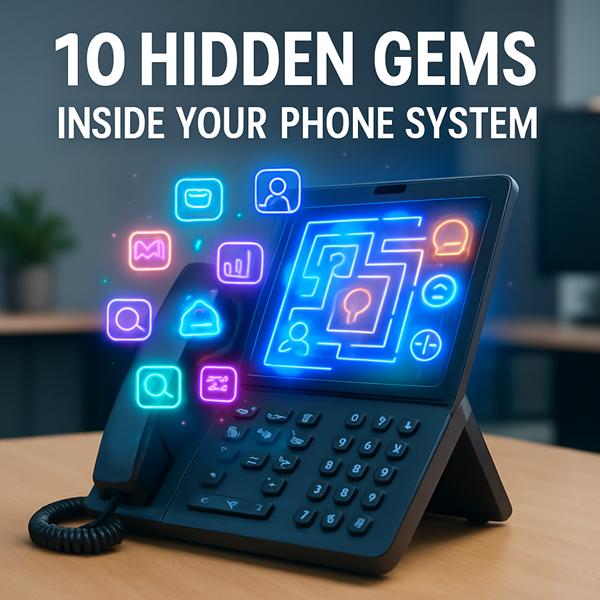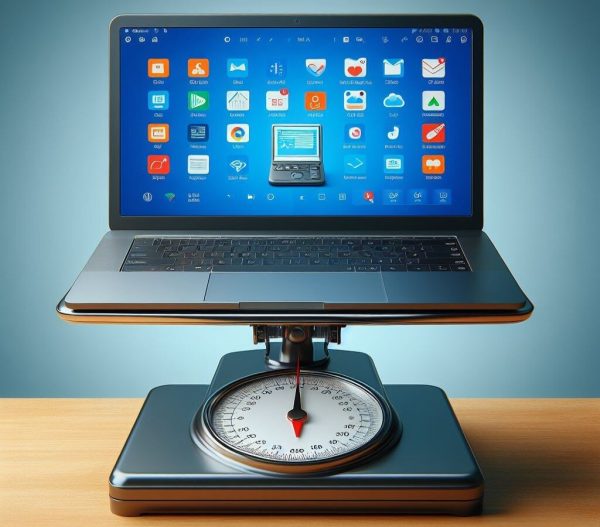Think your VoIP phone is just for making calls? Think again.
In Australia, the shift to VoIP (Voice over Internet Protocol) phone systems has quietly transformed the way homes and businesses communicate. Whether you’re aware of it or not, the traditional phone lines and copper landline network (PSTN – public switched telephone network) has been phased out, and nearly every household and workplace now operates on internet-based telephony for phone calls. This transition—driven by the rollout of the NBN and the retirement of legacy infrastructure—means that even the most basic phone setup today is powered by some of the most advanced communication technology available.
“Every one of PIPs Phone Connections whether for a home or business is connected to your very own advanced PBX system.”
Yet despite this leap forward, many users are still unaware of the powerful features built into their VoIP phone service. From mobile integration and intelligent call routing to AI-powered transcription and remote voicemail access, these systems offer capabilities that were once reserved for large enterprises. If you’re using a VoIP phone—whether at home, in the office, or on the go—you’re sitting on a goldmine of functionality.
Below are 10 top technology gems you should be using today to unlock the full potential of your phone system.
1. Voicemail-To-Email Integration
VoIP PBX systems offer a highly efficient voicemail-to-email feature that transforms how users manage missed calls. Instead of manually checking voicemail on a desk phone—often triggered by a flashing light or audible alert—users can have all voicemail messages automatically forwarded to their email inbox. This eliminates the need to dial into a voicemail system, navigate menus, or remember PIN codes. The messages typically arrive as audio attachments (e.g., MP3 or WAV files), often accompanied by caller ID, timestamp, and sometimes even a transcription.
This functionality is especially valuable for professionals who work across multiple locations or devices. Whether you’re at your desk, working remotely, or on the move with your mobile phone, you can access voicemails instantly through your email client. It streamlines communication, reduces response time, and ensures that important messages aren’t overlooked due to missed notifications or device limitations.
Beyond convenience, voicemail-to-email also supports better organisation and archiving. Messages can be stored, searched, and categorised alongside other business correspondence. For teams that rely on prompt follow-ups—such as sales, support, or journalism—this feature helps maintain continuity and responsiveness without the friction of traditional voicemail systems.
2. Follow Me / Find Me Routing
Your VoIP phone system offers a feature known as Follow-Me, which ensures that your receive phone calls no matter where you are or which device you’re using. This feature works by creating a personalised call routing sequence that follows you across multiple devices and locations. When someone calls your extension, the system can ring your desk phone, mobile phone, home office handset, or even a softphone app—either simultaneously or in a specific order—until you answer.
The configuration of Follow-Me is highly flexible. You can set variables such as:
- Ring order (e.g., desk phone first, then mobile)
- Ring duration for each device
- Time-of-day rules (e.g., route to mobile after hours)
- Caller ID filtering (e.g., only route VIP calls to mobile)
- Do Not Disturb overrides or voicemail fallback
For example, imagine you’re a journalist working from both a newsroom and the field. You configure Follow-Me so that telephone calls to your extension first ring your desk phone for 10 seconds, then your mobile phone, and finally your softphone app on your desktop or notebook if unanswered. If you’re travelling, you can update the settings remotely via your PBX console to prioritise your mobile. This ensures you never miss an important call, regardless of your location, and provides a seamless communication experience across your devices.
3. Advanced & Variable Night Switch Capabilities
VoIP PBX systems offer advanced and highly customisable night switch capabilities, which allow businesses to manage incoming VoIP calls outside of regular working hours with precision and flexibility. Unlike traditional systems that rely on manual toggling or basic voicemail, modern VoIP PBX platforms can automatically activate night mode based on time schedules, holidays, or even user presence. This ensures that calls are handled professionally and efficiently, even when the office is closed.
There are several variations of night switch configurations. You can set up automated messages that inform callers of business hours and offer options such as pressing a key to forward the call to a mobile number or another department. Alternatively, calls can be routed directly to voicemail, external numbers, or on-call staff based on predefined rules. Systems also support automated email or SMS responses, providing callers with useful information like support links, emergency contacts, or estimated response times. These rules can be tailored by extension, department, or caller ID, allowing for granular control over how different types of calls are treated after hours.
For example, a media agency might configure its night switch so that calls to the editorial team after 6 PM trigger a message saying, “Our newsroom is closed. Press 1 to reach the on-call journalist, or press 2 to leave a message.” Pressing 1 forwards the call to a mobile number assigned to the duty reporter, while pressing 2 sends the voicemail to the team’s shared email inbox. Meanwhile, calls to the sales department might go straight to voicemail with a follow-up email sent to the sales manager. This setup ensures that urgent calls are never missed, while routine inquiries are handled efficiently without disturbing staff unnecessarily.
4. Call Recordings Straight to your Private Desktop.
VoIP PBX (Private Branch Exchange) systems offer powerful call recording capabilities that go far beyond traditional telephony. Because these systems are software-driven and internet-based, they allow for highly customisable recording rules. You can choose to record all calls, only specific extensions, or filtered selections based on criteria like time of day, caller ID, department, or call direction (inbound vs. outbound). This flexibility is especially useful for businesses that need to comply with industry regulations, monitor service quality, or train staff.
Once calls are recorded, they are typically stored securely on the PBX server or a connected cloud storage system. Users with the appropriate permissions can access these recordings through a web-based PBX console, whether they’re working from the office or remotely. The interface usually allows you to search by date, extension, or caller, and play back recordings directly in your browser. Some systems also support downloading or sharing recordings for further analysis or archiving.
These recordings serve a wide range of purposes. In customer service environments, they’re used to review interactions for quality assurance and coaching. In legal or financial sectors, they help meet compliance requirements by providing a verifiable record of conversations. They can also be invaluable for resolving disputes, verifying verbal agreements, or simply revisiting complex discussions. With VoIP PBX systems, call recording becomes a strategic tool that enhances accountability, transparency, and operational efficiency.
5. Complete Mobility
VoIP (Voice over Internet Protocol) phone systems are fundamentally internet-based, which means they transmit voice calls as digital data over the internet rather than through traditional copper telephone lines. This shift to IP-based communication allows users to make and receive calls from virtually anywhere in the world, as long as they have an internet connection. Unlike legacy systems that tie a phone number to a physical location, VoIP systems associate your number or extension with your user account, not a specific device or place.
Because of this flexibility, your VoIP number or extension can be active on multiple devices at once. You can have a desk phone at the office, another VoIP handset at home, and a softphone app on your mobile—all ringing simultaneously or consecutively, when someone calls your number. This is particularly useful for hybrid or remote work setups, where you might move between locations but still want to maintain seamless communication. Features like call forwarding, simultaneous ringing, and unified voicemail ensure that your experience is consistent across all VoIP phones.
6. Your Mobile Phone as a Handset
VoIP (Voice over Internet Protocol) phone systems are built on internet infrastructure, which means they transmit voice calls as digital data packets over IP networks rather than traditional telephone lines. This internet-based design allows your phone number or extension to be tied to your user account rather than a specific physical device or location. As a result, you can use your business number from anywhere in the world, on any device that has internet access.
One of the most powerful benefits of this setup is the ability to use your mobile phone as an extension of your office phone system. With a VoIP app installed, your mobile device can make and receive calls using your work number, access voicemail, view call logs, and even participate in conference calls—just like your desk phone. This means you’re reachable whether you’re at your desk, working remotely, or travelling, without needing to share a personal number or juggle multiple devices.
Additionally, VoIP systems support simultaneous device registration, so your extension can be active on multiple handsets at once. You could have a desk phone at the office, another at home, and your mobile phone all connected to the same account. Incoming calls ring on all devices, and you can answer from whichever is most convenient. This flexibility is ideal for hybrid work environments and ensures seamless communication across locations.
7. Unlimited Phone Lines
Unlike traditional phone systems that rely on physical copper lines and hardware-based limitations, VoIP PBX systems operate entirely over the internet. This means that the concept of a “line” is no longer tied to a physical cable or port. In legacy setups, businesses were restricted by how many physical lines they could install, often requiring costly infrastructure upgrades to add more capacity. With VoIP, however, the number of simultaneous calls—or “lines”—is determined by software and bandwidth, not hardware. This allows businesses to scale up or down instantly, adding or removing virtual lines as needed without any physical changes.
VoIP telephone systems can support an unlimited number of extensions, departments, or concurrent calls, depending only on the system’s configuration and internet capacity. This flexibility is especially beneficial for growing businesses, remote teams, or organisations with fluctuating call volumes. You can have dozens or even hundreds of users connected to the same system, each with their own extension, voicemail, and call routing rules—all managed centrally through a web-based interface.
For example, a national support centre might have 50 agents working from different cities across Australia. With VoIP, each agent can have their own extension, and the system can handle hundreds of incoming VoIP calls simultaneously, routing them intelligently based on availability, skill set, or time of day. There’s no need to install new lines or worry about physical limitations—just configure the system and go. This scalability and freedom make VoIP PBX systems a game-changer for modern communication.
8. Unlimited Offices, Homes, Locations or Extensions
With a PIP VoIP PBX and phone system, your business can operate as a truly unified communications network—no matter how many offices, home setups, or remote locations you have. Unlike traditional phone systems that rely on physical infrastructure and fixed lines, PIP VoIP systems are internet-based and centrally managed. This means you can connect thousands of extensions across multiple sites under one seamless phone system, giving your company enterprise-grade connectivity without the complexity or cost of legacy telecom setups.
Each extension—whether it’s on a desk phone in Sydney, a mobile in Perth, or a softphone on a laptop in a home office—can be part of the same PBX environment. VoIP Calls between extensions are free, and internal communication is instant, secure, and scalable. You can route calls intelligently, share voicemail systems, manage call queues, and apply unified policies across all locations.
For example, a company with offices in Melbourne, Brisbane, and Auckland could have every employee connected to the same PIP PBX system. Staff can dial each other using short extension numbers, transfer VoIP calls between cities, and receive voicemails via email—all without paying for long-distance or mobile charges. Whether you’re expanding nationally or operating globally, PIP VoIP gives you the tools to stay connected as one cohesive organisation.
9. Voice, Video Conferencing & Messaging – Unified Communications
With a VoIP phone system, businesses can unlock the full potential of unified communications, a concept that brings together multiple communication channels—voice, video conferencing, messaging, presence, and collaboration—into a single, integrated platform. Unlike traditional phone systems that operate in silos, VoIP enables seamless interaction across devices and locations, allowing users to switch between calls, video meetings, instant messaging, and file sharing without leaving their communication environment.
Unified communications are typically accessed through desktop IP phones, mobile apps, mobile devices, desktop PCs or browser-based dashboards. These platforms allow employees to see who’s available (presence), initiate or join video calls, send instant messages, access voicemails, and even collaborate on documents—all from one interface. For example, a journalist working remotely can receive a voicemail as an email, reply via chat, and escalate the conversation to a video call—all within the same system. This integration boosts productivity, reduces response times, and enhances team collaboration.
In practical terms, unified communications are used across industries to streamline workflows. Customer service teams use it to manage calls and chat in real time, sales teams use it to track interactions and follow up instantly, and remote workers rely on it to stay connected with colleagues and clients. With a VoIP phone system, unified communications are no longer a luxury—they’re a standard feature that transforms how modern businesses operate.
10. Call Transcription and AI Summaries
Voice Call Transcription
VoIP phone systems offer advanced features that go beyond voice communication, including the ability to automatically transcribe calls and deliver those transcriptions directly to your email or cloud storage. These systems use speech-to-text engines to convert spoken dialogue into readable text in real time or shortly after the call ends. This means that whether you’re working from your office desktop or remotely from home, you can access a searchable record of conversations without needing to replay audio files. The transcriptions are typically stored securely and can be integrated with your business’s document management or CRM systems for easy retrieval and analysis.
Voice Call AI Processing
In conjunction with transcription, many VoIP service providers support integration with AI engines that can process these call transcripts to extract valuable data. This data might include customer sentiment, frequently asked questions, compliance keywords, action items, or even sales opportunities. For example, AI can flag phrases that indicate dissatisfaction, urgency, or interest in a product, helping teams respond proactively. It can also identify recurring issues or trends across multiple calls, which is useful for improving service delivery or refining product offerings.
The business benefits of this capability are substantial. Automated transcription and AI analysis reduce the need for manual note-taking, improve accuracy, and enable faster decision-making. They also enhance compliance monitoring, support training and quality assurance, and provide actionable insights that can drive strategic improvements. Ultimately, these tools help businesses become more responsive, data-driven, and customer-focused.
Ready to Unlock Your Phone System?
VoIP technology has quietly revolutionised communication in Australia, giving every home and business access to enterprise-grade phone systems—often without even realising it. From unlimited lines and mobile extensions to AI-powered transcriptions and intelligent call routing, today’s VoIP PBX systems are packed with features that can dramatically improve how you connect, collaborate, and operate.
Whether you’re managing a remote team, running a multi-site business, or simply looking to streamline your daily communications, these hidden gems offer powerful tools that rival traditional phone systems of yester year that cost thousands. The best part? Most of these features are already built into your system, just waiting to be activated.
If you’d like further information on what your phone system can do—or help unlocking its full potential—please contact us today.







